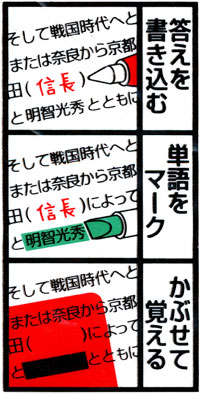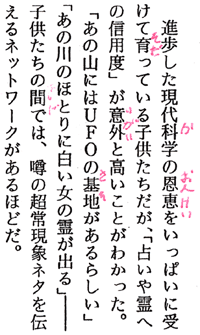When I lived in Japan, I used to commute to school every morning on trains packed with kids on their way to school. I noticed many of the High School students were doing the strangest things, they all had little red and green pieces of plastic and little sheets of paper. I asked them about it and they said it was a Check Sheet, and they showed me how to use it.

The Check Sheet is a simple study aid, widely used in cram schools in Japan. There are several variations but this illustration from the back of a Check Sheet package should explain the basic idea. The Check Sheet itself is a transparent rectangle of red plastic, usually about the width of a page. The Check Sheet system includes red and green pens and highlighters. You can see from the illustration that if you write in red, when you hold the red filter over it, the red text will be invisible. Use a green highlighter to cover a word, the red filter will make it opaque black. Very clever. There is a second type of Check Sheet, it is a bar of two strips of plastic, one red and one green. You can use the green side of the sheet, and the effect is exactly opposite, the green pen is transparent and the red ink is opaque.
I used to see kids cramming lists of English vocabulary written on little strips of paper. They would write a list of vocabulary words in English in red pen, and the Japanese definitions in green pen. They held the list under the Check Sheet, guessed each word, and then slid the sheet down one entry so the word popped up from the edge of the sheet, unfiltered, revealing the answer. Then you flip the ruler upside down and use the green side, and go down the list of definitions, written in green and now invisible. Very very clever. I liked this scheme so I bought some Check Sheets and the special pens, but I was unable to find the proper green pens and highlighters so I just used the red pens.

Here's a little sample of my furigana notes from a textbook I was using when I discovered the Check Sheet. My teacher would get furious if we put furigana notations in our textbooks. We would read these passages aloud in class, and if we had pronunciation hints, he thought it was cheating. But with the Check Sheet, I could keep the furigana concealed, only revealing it when I got stuck. I could practice it over and over, sliding the sheet to the left to reveal the hints as needed, eventually I would not need the hints. This study method seemed to satisfy the teacher as non-cheating. Sheesh! But the teacher may have had a point. Furigana is a crutch. You need margin notes but you need some way to make them fade away so you can do it the hard way and get proper practice.
You can adapt the red/green filters to your own study methods in a variety of ways. Any red or green plastic will work fine, but the Japanese plastic rulers can sometimes be obtained at specialized Japanese stationery stores. The Check Sheet pens are perfectly matched to the filters, you must use exactly the right color or the ink doesn't go fully invisible. But the official Check Sheet pens can be hard to find so you may need to find a substitute. I found that art supply stores have "designer markers" in fine gradations across the color spectrum, and it was not hard to find a matching red and green felt tip markers that worked with the Check Sheet.
I think the Check Sheet system is particularly well adapted for Japanese second language learners, because they have the triple task of learning vocabulary with three parts: the meaning, the kanji, and the reading (pronunciation). I often joke that studying Japanese vocabulary requires three-sided flash cards. But with the red/green Check Sheets plus red/green pens and highlighters, you actually have 8 ways to conceal and reveal information. Just pick which 3 work the best for your context, and you have the functional equivalent of three-sided flash cards.

The Check Sheet is a simple study aid, widely used in cram schools in Japan. There are several variations but this illustration from the back of a Check Sheet package should explain the basic idea. The Check Sheet itself is a transparent rectangle of red plastic, usually about the width of a page. The Check Sheet system includes red and green pens and highlighters. You can see from the illustration that if you write in red, when you hold the red filter over it, the red text will be invisible. Use a green highlighter to cover a word, the red filter will make it opaque black. Very clever. There is a second type of Check Sheet, it is a bar of two strips of plastic, one red and one green. You can use the green side of the sheet, and the effect is exactly opposite, the green pen is transparent and the red ink is opaque.
I used to see kids cramming lists of English vocabulary written on little strips of paper. They would write a list of vocabulary words in English in red pen, and the Japanese definitions in green pen. They held the list under the Check Sheet, guessed each word, and then slid the sheet down one entry so the word popped up from the edge of the sheet, unfiltered, revealing the answer. Then you flip the ruler upside down and use the green side, and go down the list of definitions, written in green and now invisible. Very very clever. I liked this scheme so I bought some Check Sheets and the special pens, but I was unable to find the proper green pens and highlighters so I just used the red pens.

Here's a little sample of my furigana notes from a textbook I was using when I discovered the Check Sheet. My teacher would get furious if we put furigana notations in our textbooks. We would read these passages aloud in class, and if we had pronunciation hints, he thought it was cheating. But with the Check Sheet, I could keep the furigana concealed, only revealing it when I got stuck. I could practice it over and over, sliding the sheet to the left to reveal the hints as needed, eventually I would not need the hints. This study method seemed to satisfy the teacher as non-cheating. Sheesh! But the teacher may have had a point. Furigana is a crutch. You need margin notes but you need some way to make them fade away so you can do it the hard way and get proper practice.
You can adapt the red/green filters to your own study methods in a variety of ways. Any red or green plastic will work fine, but the Japanese plastic rulers can sometimes be obtained at specialized Japanese stationery stores. The Check Sheet pens are perfectly matched to the filters, you must use exactly the right color or the ink doesn't go fully invisible. But the official Check Sheet pens can be hard to find so you may need to find a substitute. I found that art supply stores have "designer markers" in fine gradations across the color spectrum, and it was not hard to find a matching red and green felt tip markers that worked with the Check Sheet.
I think the Check Sheet system is particularly well adapted for Japanese second language learners, because they have the triple task of learning vocabulary with three parts: the meaning, the kanji, and the reading (pronunciation). I often joke that studying Japanese vocabulary requires three-sided flash cards. But with the red/green Check Sheets plus red/green pens and highlighters, you actually have 8 ways to conceal and reveal information. Just pick which 3 work the best for your context, and you have the functional equivalent of three-sided flash cards.

Leave a comment